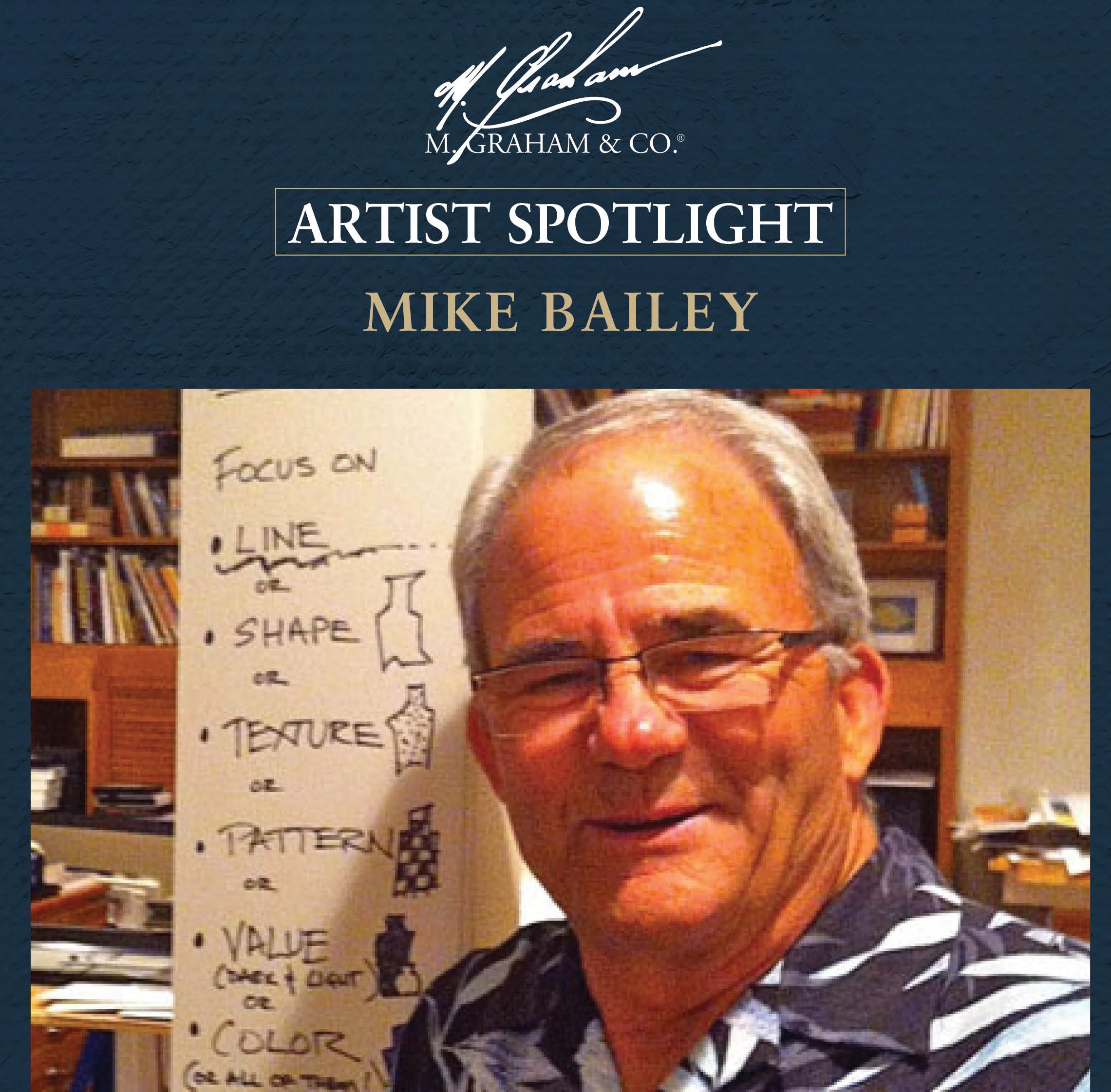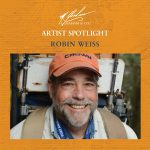
Artist Spotlight: Mike Bailey
Member of American Watercolor Society (AWS) and the National Watercolor Society (NWS), artist Mike Bailey @me_bailey_art discusses advice he taught from his intensive college art course, becoming a member of watercolor societies and his transition from a career in high technology to being a self-taught artist in his interview for the latest M. Graham blog.
You tell us that you picked up painting mid-life, being a graduate from San Jose State University with degrees in Engineering and Business. What inspired you to start painting?
My inspiration ‘attacked’ me in elementary school! I can still recall the absolute magical pleasure of being transported while painting watercolors in the 3rd grade! I was in love with art then. As I grew older, as in many families, my parents discouraged a career in art so that I “could make a living.” As I reached middle age, I needed to find something to relieve stress and take my mind off the challenges at my job in high tech. I began fooling around with the painting at age 46. It soon fully captured my every thought! It wasn’t long before I was thinking I would love the opportunity to paint full time. After a few episodes of being ‘downsized’ at work, I took a temporary job in the roofing industry, which quickly became a permanent occupation. Where I live, it rains a lot in the winter months. Roofers don’t work during the rain. Instead I painted at home on rainy days. Thus, gaining the needed brush miles to really know my medium.
What resources did you utilize to become a self-taught artist?
The habit of reading before falling asleep served me for a while. I read every magazine and book about watercolor I could get my hands on. Of course, after reading about watercolor before falling asleep, my dreams were filled with paintings! I took a few workshops when I could get time off work. Gerald Brommer and Christopher Schink made an enormous impact on my study of design. I would say that the biggest resource was time at my easel. I kept working at making hundreds of paintings a year until I had put in the 10,000 hours needed to be considered ‘good’ at it. I also took up the study of art via an art history college course and lots of museum visits.
What drew you to watercolor over other painting mediums?
I wish I could put my finger on it! The thin veils of color and that look of wetness from watercolor has held my fascination from the first moment it entered my life in elementary school. Somewhere down inside of me, it called to me and still does. It is a very capricious medium, which keeps truly mastering it tantalizingly out of reach.
Who are the biggest influences to your painting style and in what ways?
Without a doubt, Christopher Schink made enormous impact on my consciousness about the ins and outs of design. His very bold painting style has held my fascination for decades. At first, I did some emulations of his style. As I grew into deeper thinking about making art, his analytical and thoughtful approach to making art steered me away from technique and into trying to understand the underlying structures of ‘good’ paintings. I suppose my own analytical nature was responsible for that too. To this day, I look up to him as a dear and trusted advisor, although we see very little of each other.
What makes M. Graham watercolors stand out from other watercolor paints you have used?
Over the years, I have tried nearly every watercolor brand on the market. At first, access to good paints was the determining factor in making choices. As my painting prowess developed, I could see very obvious differences in the choices out there. My very first trial of M. Graham watercolor paints was a shocker! I could not believe the pigment load in the watercolor paints and how easily they went into solution even after sitting on my palette for weeks. I see M. Graham’s paints as being the ‘gold standard’ to which other manufacturers should strive.
Which four M. Graham watercolor paints will we always find on your palette?
That’s easy! Cobalt Blue, Azo Yellow, Azo Orange and Ultramarine Violet (among others!). I use M. Graham’s Cobalt Blue as the example of exquisitely made watercolor paint, when compared with other watercolor paint manufacturers.
What is the greatest challenge that you have experienced with your art and how do you overcome it?
That question is a HUGE question because the answer is multi-fold! I had to really think about this one. The biggest challenge for me is to be as authentic as I possibly can in my artwork. That is not easy, especially when I am so easily affected by another artists’ work. Viewing other works can set me off on a side trip very quickly, and that is dangerous! What has kept me trying to be authentic is to work in series in a very restricted way. That means to begin with a single subject and to progressively modify it over many, many paintings. After a time and several paintings about that subject, the outside influences get tried and used and become tired. The subject becomes boring when the artist must invent in order to have the progression of modification continue. After twenty-five or thirty paintings, I have found that I have exhausted all of the easy options and made the most creative work. Interestingly, I have rarely gone public with this genre of work. It is what you might call my “homework.”
One of the things you are known for is for developing and teaching the college art course “Painting Beyond the Obvious” at the University of California at Santa Cruz. What is “artistic understanding”, as defined by this course?
It is funny, in a peculiar way, how this class has taken on a life of its own! In my zeal to study and learn about design, this class was sort of an outfall of that process. The class is ten weeks long and strives to break habitual thinking of painting ‘pretty pictures’ of something and stresses the elements and principles of design, versus teaching technique. The objective is to urge every painter to overcome the tyranny of the subject, and how to paint it, to emphasize one or two design elements (Line, Size, Shape, Direction, Color, Value and Texture) over a series of twenty full-sheet paintings. This process calls up every artist’s creativity. Most find it to be a big stretch of effort because considering the process of design while painting is very unfamiliar. What happens is that each artist discovers that, as individual painters, they are naturally inclined to use one or two design elements in their work. One painter may emphasize value in her work, while another might emphasize color. This natural inclination shows up over their series of twenty paintings, usually without the artist being conscious of their ‘style’ (tendency of using certain design elements).
There is much discussion and mental exercise in the course, which is the bridge from “beginner thinking” to advanced painting and thinking. In short, the class is a crucible in which painters are forced to create, not copy, while developing a practice of relying on the elements and principles of design. The class is a challenge for everyone who takes it! While no longer at the university, the class has filled seats for twenty consecutive years!
The goal of the class is “artistic understanding”, introducing the painter to fully integrate the principles and elements of design and critiques into their painting technique to familiarize them with the language of fine art.
As a recipient of numerous national and international awards, and as a member of both the American Watercolor Society (AWS) and the National Watercolor Society (NWS), what does it take to become an award-winning watercolorist?
That is a question to which everyone wants the answer and there are a lot of opinions out there. First off, don’t be casual about entering these shows. The artist must seriously prepare! That means planning to seriously develop the very best work possible. I would suggest not choosing a trite subject. Paint a subject not usually seen in watercolor paintings. That is to say, if you have seen it before, choose something else. That will nearly always attract the juror’s attention. Be different! Secondly, the paintings that are accepted by AWS and NWS are paintings that are evidence of very highly focused work to develop a masterly painting; the artist carefully works out a highly refined design out of many trials. In my own case, it took doing the painting over again up to three different times before it was considered worthy. Having been a juror at NWS, and a judge in other shows, the awarded paintings display excellent design and obvious creativity. Excellent technique rarely counts for anything! It is usually last on the juror’s list of criteria. Content also plays a big part, which is the emotion or message of the painting. Always, always, always, design is the leading reason for acceptance in these painting societies.
Follow Mike Bailey
Facebook: M. E. “Mike” Bailey, Artist
Instagram: @me_bailey_art
Website: mebaileyart.com


